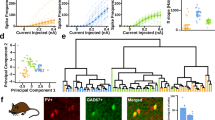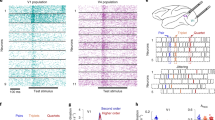Abstract
Synaptic inputs underlying spike receptive fields are important for understanding mechanisms of neuronal processing. Using whole-cell voltage-clamp recordings from neurons in mouse primary visual cortex, we examined the spatial patterns of their excitatory and inhibitory synaptic inputs evoked by On and Off stimuli. Neurons with either segregated or overlapped On/Off spike subfields had substantial overlaps between all the four synaptic subfields. The segregated receptive-field structures were generated by the integration of excitation and inhibition with a stereotypic 'overlap-but-mismatched' pattern: the peaks of excitatory On/Off subfields were separated and flanked colocalized peaks of inhibitory On/Off subfields. The small mismatch of excitation/inhibition led to an asymmetric inhibitory shaping of On/Off spatial tunings, resulting in a great enhancement of their distinctiveness. Thus, slightly separated On/Off excitation, together with intervening inhibition, can create simple-cell receptive-field structure and the dichotomy of receptive-field structures may arise from a fine-tuning of the spatial arrangement of synaptic inputs.
This is a preview of subscription content, access via your institution
Access options
Subscribe to this journal
Receive 12 print issues and online access
$209.00 per year
only $17.42 per issue
Buy this article
- Purchase on Springer Link
- Instant access to full article PDF
Prices may be subject to local taxes which are calculated during checkout






Similar content being viewed by others
References
Hubel, D.H. & Wiesel, T.N. Receptive fields, binocular interaction and functional architecture in the cat's visual cortex. J. Physiol. (Lond.) 160, 106–154 (1962).
Heggelund, P. Quantitative studies of the discharge fields of single cells in cat striate cortex. J. Physiol. (Lond.) 373, 277–292 (1986).
Hirsch, J.A., Alonso, J.M., Reid, R.C. & Martinez, L.M. Synaptic integration in striate cortical simple cells. J. Neurosci. 18, 9517–9528 (1998).
Troyer, T.W., Krukowski, A.E., Priebe, N.J. & Miller, K.D. Contrast-invariant orientation tuning in cat visual cortex: feedforward tuning and correlation-based intracortical connectivity. J. Neurosci. 18, 5908–5927 (1998).
Miller, K.D. Understanding layer 4 of the cortical circuit: a model based on cat V1. Cereb. Cortex 13, 73–82 (2003).
Hirsch, J.A. & Martinez, L.M. Circuits that build visual cortical receptive fields. Trends Neurosci. 29, 30–39 (2006).
Ferster, D. & Miller, K.D. Neural mechanisms of orientation selectivity in the visual cortex. Annu. Rev. Neurosci. 23, 441–471 (2000).
Hirsch, J.A. et al. Functionally distinct inhibitory neurons at the first stage of visual cortical processing. Nat. Neurosci. 6, 1300–1308 (2003).
Ferster, D. Spatially opponent excitation and inhibition in simple cells of the cat visual cortex. J. Neurosci. 8, 1172–1180 (1988).
Borg-Graham, L.J., Monier, C. & Frégnac, Y. Visual input evokes transient and strong shunting inhibition in visual cortical neurons. Nature 393, 369–373 (1998).
Sillito, A.M. The contribution of inhibitory mechanisms to the receptive field properties of neurones in the striate cortex of the cat. J. Physiol. (Lond.) 250, 305–329 (1975).
Nelson, S., Toth, L., Sheth, B. & Sur, M. Orientation selectivity of cortical neurons during intracellular blockade of inhibition. Science 265, 774–777 (1994).
Carandini, M. & Ferster, D. Membrane potential and firing rate in cat primary visual cortex. J. Neurosci. 20, 470–484 (2000).
Mechler, F. & Ringach, D.L. On the classification of simple and complex cells. Vision Res. 42, 1017–1033 (2002).
Abbott, L.F. & Chance, F.S. Rethinking the taxonomy of visual neurons. Nat. Neurosci. 5, 391–392 (2002).
Priebe, N.J., Mechler, F., Carandini, M. & Ferster, D. The contribution of spike threshold to the dichotomy of cortical simple and complex cells. Nat. Neurosci. 7, 1113–1122 (2004).
Palmer, L.A. & Davis, T.L. Receptive-field structure in cat striate cortex. J. Neurophysiol. 46, 260–276 (1981).
Dean, A.F. & Tolhurst, D.J. On the distinctness of simple and complex cells in the visual cortex of the cat. J. Physiol. (Lond.) 344, 305–325 (1983).
Jones, J.P. & Palmer, L.A. The two-dimensional spatial structure of simple receptive fields in cat striate cortex. J. Neurophysiol. 58, 1187–1211 (1987).
Mata, M.L. & Ringach, D.L. Spatial overlap of ON and OFF subregions and its relation to response modulation ratio in macaque primary visual cortex. J. Neurophysiol. 93, 919–928 (2005).
Martinez, L.M. et al. Receptive field structure varies with layer in the primary visual cortex. Nat. Neurosci. 8, 372–379 (2005).
Zhang, L.I., Tan, A.Y.Y., Schreiner, C.E. & Merzenich, M.M. Topography and synaptic shaping of direction selectivity in auditory cortex. Nature 424, 201–205 (2003).
Wehr, M. & Zador, A.M. Balanced inhibition underlies tuning and sharpens spike timing in auditory cortex. Nature 426, 442–446 (2003).
Higley, M.J. & Contreras, D. Balanced excitation and inhibition determine spike timing during frequency adaptation. J. Neurosci. 26, 448–457 (2006).
Liu, B.H., Wu, G.K., Arbuckle, R., Tao, H.W. & Zhang, L.I. Defining cortical frequency tuning with recurrent excitatory circuitry. Nat. Neurosci. 10, 1594–1600 (2007).
Wu, G.K., Arbuckle, R., Liu, B.H., Tao, H.W. & Zhang, L.I. Lateral sharpening of cortical frequency tuning by approximately balanced inhibition. Neuron 58, 132–143 (2008).
Dräger, U.C. Receptive fields of single cells and topography in mouse visual cortex. J. Comp. Neurol. 160, 269–290 (1975).
Mangini, N.J. & Pearlman, A.L. Laminar distribution of receptive field properties in the primary visual cortex of the mouse. J. Comp. Neurol. 193, 203–222 (1980).
Métin, C., Godement, P. & Imbert, M. The primary visual cortex in the mouse: receptive field properties and functional organization. Exp. Brain Res. 69, 594–612 (1988).
Niell, C.M. & Stryker, M.P. Highly selective receptive fields in mouse visual cortex. J. Neurosci. 28, 7520–7536 (2008).
Liu, B.H. et al. Visual receptive field structure of cortical inhibitory neurons revealed by two-photon imaging guided recording. J. Neurosci. 29, 10520–10532 (2009).
Tan, A.Y.Y., Zhang, L.I., Merzenich, M.M. & Schreiner, C.E. Tone-evoked excitatory and inhibitory synaptic conductances of primary auditory cortex neurons. J. Neurophysiol. 92, 630–643 (2004).
Petreanu, L., Mao, T., Sternson, S.M. & Svoboda, K. The subcellular organization of neocortical excitatory connections. Nature 457, 1142–1145 (2009).
Debanne, D., Shulz, D.E. & Fregnac, Y. Activity-dependent regulation of 'on' and 'off' responses in cat visual cortical receptive fields. J. Physiol. (Lond.) 508, 523–548 (1998).
Tao, H.W. & Poo, M.M. Activity-dependent matching of excitatory and inhibitory inputs during refinement of visual receptive fields. Neuron 45, 829–836 (2005).
Liu, Y., Zhang, L.I. & Tao, H.W. Heterosynaptic scaling of developing GABAergic synapses: dependence on glutamatergic input and developmental stage. J. Neurosci. 27, 5301–5312 (2007).
Dantzker, J.L. & Callaway, E.M. Laminar sources of synaptic input to cortical inhibitory interneurons and pyramidal neurons. Nat. Neurosci. 3, 701–707 (2000).
Yoshimura, Y. & Callaway, E.M. Fine-scale specificity of cortical networks depends on inhibitory cell type and connectivity. Nat. Neurosci. 8, 1552–1559 (2005).
Wagor, E., Mangini, N.J. & Pearlman, A.L. Retinotopic organization of striate and extrastriate visual cortex in the mouse. J. Comp. Neurol. 193, 187–202 (1980).
Moore, C.I. & Nelson, S.B. Spatio-temporal subthreshold receptive fields in the vibrissa representation of rat primary somatosensory cortex. J. Neurophysiol. 80, 2882–2892 (1998).
Margrie, T.W., Brecht, M. & Sakmann, B. In vivo, low-resistance, whole-cell recordings from neurons in the anaesthetized and awake mammalian brain. Pflugers Arch. 444, 491–498 (2002).
de la Cera, E.G., Rodríguez, G., Llorente, L., Schaeffel, F. & Marcos, S. Optical aberrations in the mouse eye. Vision Res. 46, 2546–2553 (2006).
Green, D.G., Powers, M.K. & Banks, M.S. Depth of focus, eye size and visual acuity. Vision Res. 20, 827–835 (1980).
Remtulla, S. & Hallett, P.E. A schematic eye for the mouse and comparisons with the rat. Vision Res. 25, 21–31 (1985).
Jagadeesh, B., Wheat, H.S., Kontsevich, L.L., Tyler, C.W. & Ferster, D. Direction selectivity of synaptic potentials in simple cells of the cat visual cortex. J. Neurophysiol. 78, 2772–2789 (1997).
Somers, D.C., Nelson, S.B. & Sur, M. An emergent model of orientation selectivity in cat visual cortical simple cells. J. Neurosci. 15, 5448–5465 (1995).
Hines, M. NEURON—a program for simulation of nerve equations. in Neural Systems: Analysis and Modeling (ed. Eeckman, F.) 127–136 (Spring, New York, 1993).
Schiller, P.H., Finlay, B.L. & Volman, S.F. Quantitative studies of single-cell properties in monkey striate cortex. I. Spatiotemporal organization of receptive fields. J. Neurophysiol. 39, 1288–1319 (1976).
Azzalini, A. & Capitanio, A. Statistical applications of the multivariate skew-normal distribution. J. R. Stat. Soc. Series B Stat. Methodol. 61, 579–602 (1999).
Acknowledgements
We thank A. Sampath and D. Li for their helpful suggestions. This work was supported by grants to H.W.T. from the US National Institutes of Health (EY018718 and EY019049) and The Karl Kirchgessner Foundation. L.I.Z. is supported by the Searle Scholar Program, the Klingenstein Foundation, and the David and Lucile Packard Foundation.
Author information
Authors and Affiliations
Corresponding authors
Supplementary information
Supplementary Text and Figures
Supplementary Figures 1–9 (PDF 842 kb)
Rights and permissions
About this article
Cite this article
Liu, Bh., Li, P., Sun, Y. et al. Intervening inhibition underlies simple-cell receptive field structure in visual cortex. Nat Neurosci 13, 89–96 (2010). https://doi.org/10.1038/nn.2443
Received:
Accepted:
Published:
Issue Date:
DOI: https://doi.org/10.1038/nn.2443
This article is cited by
-
The medial preoptic area mediates depressive-like behaviors induced by ovarian hormone withdrawal through distinct GABAergic projections
Nature Neuroscience (2023)
-
Distinct organization of two cortico-cortical feedback pathways
Nature Communications (2022)
-
A new discovery on visual information dynamic changes from V1 to V2: corner encoding
Nonlinear Dynamics (2021)
-
Biophysical mechanism of the interaction between default mode network and working memory network
Cognitive Neurodynamics (2021)
-
Neural mechanism of visual information degradation from retina to V1 area
Cognitive Neurodynamics (2021)



